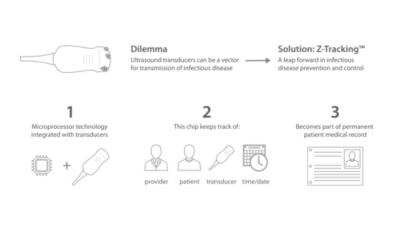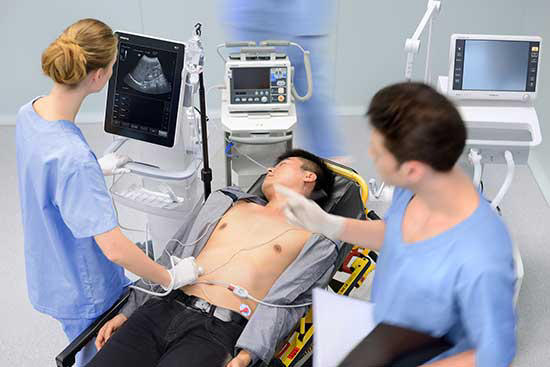The Emergency Medicine (EM) environment presents many challenges for clinicians who often deliver patient care under extreme conditions. To combat these challenges, innovation must take center stage to help improve patient throughput and elevate outcomes. Explore the top concerns in EM and learn how Mindray’s Point of Care Ultrasound (POCUS) Machines uniquely address these challenges through artificial intelligence (AI) powered Smart Tools, thoughtful industrial designs, and advanced imaging capabilities for frequently evaluated structures.
Top Issues Faced in Emergency Medicine
Patient Volumes
As the needs of today’s patient populations are changing, more and more people are visiting the Emergency Department (ED) with non-urgent needs. This has resulted in overcrowding for many EDs. Other factors that contribute to overcrowding range from prolonged length of stay, understaffed EDs, and repeat visits.1 This is a concern because it can negatively impact the quality of patient care (longer wait times, delays to diagnosis and treatment, etc.), costs, and patient satisfaction.1
Integrating POCUS Machines into EM can be an instrumental tool to help combat increasing patient volumes. POCUS exams are quick and can be done anywhere the patient is – ultrasound systems do not require as much space as other imaging modalities.
Patient Throughput
As increasing patient volumes continue to emerge as a top pain point, an emphasis has been placed on patient throughput and ensuring patients receive the high-quality care they need in a timely manner. POCUS systems can help improve patient throughout due to their portability and small footprint that allows clinicians to perform exams at the bedside, in the intake room or hallway, or wherever there is space. Ultrasound exams can help clinicians quickly and efficiently triage, diagnose, and monitor patients to help reduce unneeded wait times.
In a typical POCUS setting, a clinician may need to make a rapid decision to utilize ultrasound when performing their clinical assessment. Since this decision is made at the point of care, there typically isn’t an order in the system to associate with POCUS usage. New encounter-based workflows allow clinicians to simply walk up to the system, scan a barcode on their badge to log in, and assign privileges on the ultrasound system. The clinician can then scan the barcode on the patient’s wristband to populate the patient information screen. It can also generate an order and populate a worklist entry for that patient.
Additionally, to help optimize workflow and throughput, POCUS systems now have advanced AI-powered Smart Tools to help clinicians streamline exams and reduce intra-user variabilities in exams. Two Smart Tools designed specifically for Point of Care (POC) are Mindray’s Smart Velocity Time Integral (VTI) and Smart B-Lines. Smart VTI enables automated VTI and Cardiac Output (CO) measurements for rapid cardiac function assessment. This software automatically applies the Pulsed Wave Doppler (PW) sample line in real-time. A trending graph for CO, Stroke Volume (SV), and VTI is produced to guide decision-making. Smart B-Line allow for rapid assessment of lung tissue by automatically counting the number of B-Lines and percentage of area of B-Lines according to user-selected protocols.
Quality Assurance
In EM, clinicians need to quickly and accurately triage, diagnose, and treat patients. To do this, quality assurance is key – during life-threatening emergencies, there is no margin for error. Our POCUS systems are equipped with high-quality imaging capabilities to help clinicians reduce repeat exams or additional exams to provide a clear image. Mindray created the industry’s first revolutionary, software-driven approach to acoustic data acquisition and image formation, ZONE Sonography® Technology+ (ZST+). The advantages that ZST+ enable include:
- Advanced Acoustic Acquisition – large zones of acoustic data create individual ultrasound image frames 10 times faster.
- Dynamic Pixel Focusing – provides exquisite spatial resolution and image uniformity from skin line to the deepest depths.
- Sound Speed Compensation – with one-click, the system will automatically sample the tissue being examined and recalibrates the software to reflect its specific speed of sound for optimal contrast and lateral resolution.
- Total Recall Imaging – capture and store the complete acoustic raw data set and allows the user to retrospectively modify numerous imaging parameters and optimize clinical information.
To help clinicians achieve the highest quality standard, Mindray created iWorks™ Protocols – a powerful and customizable protocol software that provides exam consistency and can reduce scanning times by up to 50%. This workflow tool allows users to create customized workflows by exam type to ensure every image needed is acquired. The software also enables automated annotations, measurements, imaging modes, and body markers, saving keystrokes and time. iWorks increases exam efficiency, improves standardization, and lowers the risk of clinician overuse injuries.
In addition, Mindray has a proprietary image processing technique, HD Scope, that enhances B-mode tissue characterization and improves spatial and contrast resolution in a specific region of interest. HD Scope can decrease the need for additional imaging in instances of ambiguous lesions and structures, improving throughput and time to diagnosis.
Disinfection and Patient Safety
In typical POC environments, such as EDs, Intensive Care Units (ICUs), and Critical Care, disinfection is vital for patient safety. To help clinicians ensure quality and accuracy are top of mind, Mindray developed specific technologies and options that help reduce contamination and allow clinicians to disinfect systems quickly and easily.
One of those technologies is Z-Tracking™. Z-Tracking is a transducer tracking technology that can append transducer data to the patient’s medical record. Z-Tracking can help identify if a transducer has been exposed to an infectious patient/room and can quickly identify what system, transducers, and patients have been exposed to help stop the spread and help ensure disinfection and safety.

Mindray’s POCUS solutions have been uniquely designed with disinfection in mind. Some of the key capabilities to look for in a POCUS system include:
- Sealed interface for fluid resistance and ease of disinfection.
- Elevated transducer holders for improved infection control and ideal cable management.
- Screwless design eliminates exposed metal prone to rust and corrosion from disinfectants.
- Seamless touch screen design to prevent residue buildup from cleaning and disinfection and reduces the impact of continuous chemical disinfectants use.
- Retractable cord to help prevent tripping hazards and contamination.
Changing Environment and Needs
The types of exams and needs may differ drastically day-to-day in POC environments. To address varying needs, clinicians require comprehensive imaging capabilities to ensure they can provide appropriate care. Mindray’s POCUS Systems have options for battery-powered scanning capabilities, so the system can go where you go. In addition, our innovative, accessible ultrasound solutions offer sophisticated tools and technologies such as:
- Transesophageal echocardiogram (TEE) imaging
- Contrast enhanced ultrasound (CEUS)
- Needle-guidance/procedural guidance
These tools and technologies empower you to streamline workflow, minimize the risk of infection, and provide the highest quality of care now and in the future.
Keeping Up with The Latest Tools and Technology to Better Assist Clinicians
As new tools and technology become available for EDs, there may be budgetary constraints for acquiring the newest tools. In addition to financial hurdles, there can also be a learning curve for EM clinicians to master the new tools.
Mindray’s investment in next-generation, software-based ZST+ along with an exclusive Living Technology™ promise provides customers with easily upgradable software enhancements to secure product investment protection and keep their ultrasound machines at the leading edge of imaging performance. Additionally, Mindray’s POCUS Systems offer wireless DICOM encryption to protect sensitive patient information when transferred from one device to another over a system’s network.
Through industry-best investment protection, total cost of ownership, and innovative solutions, Mindray continues to drive its mission forward, advancing medical technologies to make healthcare more accessible.

The Mindray Difference
EM clinicians rely on tools and technologies to assess patients quickly and reliably. At Mindray, we believe all clinicians deserve cost-effective, reliable medical devices that empower them to provide the best possible care for their patients. We are proud to have two of Mindray’s portable ultrasound Systems recognized among the top 10 selling POC ultrasound products in 2020 – the TE7 Ultrasound Machine and M9 Ultrasound Machine2. To ensure we continue to develop the tools EM clinicians need today and, in the future, we accompany and listen to customers and create a collaborative experience that results in innovative solutions that address the challenges they face every day. Experience peace of mind and see something better with Mindray ultrasound.
References:
- https://www.ncbi.nlm.nih.gov/pmc/articles/PMC4909875/
- “The Point-Of-Care/Handheld Ultrasound Systems Market in the USA: On the Brink of Disruption? 2020 Report”, Klein Biomedical Consultants, Inc.







